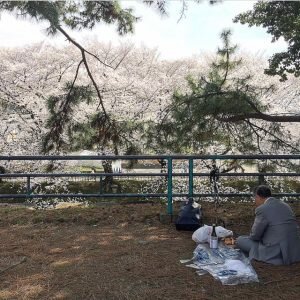Cherry blossoms bloom just two weeks out of the year.
A fleeting moment of time in which thousands and thousands of people rush to witness this brief moment of piercing beauty.
It displays the natural cycle of life. The beginning through the end and with that comes many lessons we can learn and apply to our own lives.
And, it’s fascinating because the Japanese are obsessed with them.
I felt these beautiful, (silky) smooth to the touch flowers before I left Japan.
Adorned on every corner and every sidewalk of Japan are cherry blossom trees and petals scattered all throughout the streets. When they are in bloom the view is magical!
Cherry Blossoms Connect Life With Beauty
Why are the Japanese insanely obsessed with cherry blossoms, also known as “Sakura”?
We’ll explore that in just a minute.
But during the annual cherry blossom season the Japanese plan hanami parties. Hana means flower and mi means to look. They hold festivals throughout the cities to honor this beautiful flower.
You’ll see the Japanese then picnic under the trees with friends, family, (or solo) to drink and eat (celebrating the cherry blossoms). And some companies will even shut the office down for a few hours to engage in a hanami party.

But why this big fuss over these flowers?
Well, the meaning behind it originates from the Buddhist concept of impermanence. The fragility of life. And the burst of beauty––the sight of the petals quickly withering away as they tumble to the ground without any resistance.
One thing I noticed is the Japanese in general love plants and flowers. It’s not uncommon to walk by a Japanese home to find a sea of plants and flowers encircling it. There’s this obsession with the idea that most flowers are beautiful when they are about to wilt.
“The significance of the cherry blossom tree in Japanese culture goes back hundreds of years. In their country, the cherry blossom represents the fragility and the beauty of life. It’s a reminder that life is almost overwhelmingly beautiful but that it is also tragically short.”––Homaro Cantu
The cherry blossoms begin to bloom in Okinawa at the start of March; then they work their way to Osaka, Kyoto, and Tokyo (and everything in between) ending in April.
But it’s not primarily about death because the sakura’s also symbolize spring and the renewal of life. When they are in bloom, it indicates a new season has arrived.
It’s a metaphor which illustrates a reboot and a restart for your life. In the States, it’s called spring cleaning.
But the thing about cherry blossoms is when they wilt and fall, they turn into soil only to be reborn again.
It’s an inevitable and unending process. Similar to life and how it’s always changing with or without our consent.
And so, Kyoto is said to be one of the best places to see the cherry blossoms. If you like scenery and thousand-year-old temples (and delicious food), then Kyoto has some of the best spots to witness the cherry blossoms in full.
Cherry Blossoms Embody True Wisdom (Which We can Learn From)
I witnessed the cherry blossoms in Nagoya and Tokyo. It’s a breathtaking site.


But what can the cherry blossoms teach us about life?
Be in the present moment and appreciate all that surrounds you.
Understand that life is fleeting and the moments you capture will disappear. But that’s okay. The less you attach, the more you can allow everything and everyone around you to be free––including yourself.
So, yes the cherry blossoms are pretty to look, but it carries much more astuteness than what is visible to the surface.
Let the cherry blossoms remind you how valuable life is, because like the quote below life is beautiful because of its impermanence and not in spite of it.
“The notion is called wabi-sabi life, like the cherry blossom, it is beautiful because of its impermanence, not in spite of it, more exquisite for the inevitability of loss.”––Peggy Orenstein
Please share this post with someone who will benefit from it and also subscribe to our newsletter for exclusive stuff!
Click here to leave us a rating & a review on iTunes.
Follow us on social media: Facebook | Instagram | Twitter | Pinterest | Join our Facebook Tribe

Frantzces is the co-founder of Chronicles Abroad and helps people to live a missioned driven life. She has written for Tiny Buddha, Medium and SOULE, an online publication for LGBTQ news and pop culture. Her mission in life is to inspire people to live missioned driven lives. To defy the resistance. Life is like a movie but unlike movies, there are no sequels. Click here for your FREE guide: 4 Easy Ways to Reduce Stress: Anytime, Anywhere For Less Than 15 Minutes.